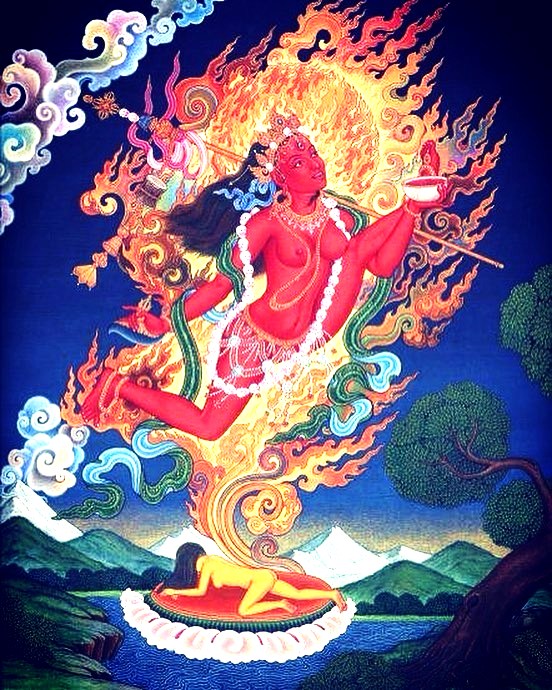Maitridakini and Indradakini

Maitridakini (Tib. Maitri Khacho) and Indradakini (Tib. Indra Khacho) are two manifestations of Vajrayogini (Tib. Dorje Naljorma), the supreme goddess in the pantheon of Vajrayana Buddhism. Just like her, they are perceived as an embodiment of complete Buddhahood in female form.
Maitridakini is a Tantric goddess, originated from the tradition of the Indian Buddhist Mahasiddha Maitripa (1007–1085), who was teacher of the great Tibetan master and translator Marpa (1012-1097). The goddess appeared in front of Maitripa in Svayambhu, Nepal and taught him the exoteric teachings.

Maitridakini, known also as Akashyogini (“space yogini”) and Vidyadhari (Tib. Rigdzinma, “knowledge holder”), is depicted red in color, with wrathful and at the same time passionate expression on her face.
The posture of her body differs from all other dakinis and gives the impression that she is flying in the sky with raised left leg held in the crook of her left arm. Sometimes she steps with the right feet on the ground while her left leg is raised. Her right hand holds a vajra or a curved knife and the left one holds a white skullcup (kapala). Some thangkas depict her drinking blood from the kapala. A trident (khatvanga) is placed on her left shoulder. Her body is decorated with traditional dakini bone ornaments and surrounded by the flames of the primordial wisdom fire.

The divine figure of Maitridakini expresses her erotic and blissful nature as well as her infinite freedom.
Indradakini (Tib. Indra Khacho) is a Tantric goddess, originated from the tradition of the Indian Buddhist Mahasiddha Indrabudhi. She is called “Varahi with two faces” (Tib. Shelnyima Phagmo) because of her resemblance to Vajravarahi (Tib. Dorje Phagmo). Just like her, she is depicted with a sow’s head on the right side of her face, which symbolizes the absolute truth beyond all delusion. Her body is red in color, with the right leg raised in a dancing posture. She holds a vajra ax in her right hand – an attribute of the extremely wrathful deities and a kapala in her left hand. The flames of the primordial wisdom are depicted around her figure.

In Tibetan thangkas of the Sakya School, Indradakini is depicted surrounded by important figures of this tradition. She is in the center of the composition with a halo of flames. Above her is King Indrabhuti, flanked by Sachen Kunga Nyingpo (1092-58), founder of the Sakya School and Tsarchen Losal Gyatso (1502-66), founder of the Tsar subschool of the Sakya. At the bottom of the thangka is Mahakala in the form of a Brahman (Brahamanarupa), surrounded by four dakinis from his retinue: black Dombini, green Chandali, red Rakshasi, and yellow Singhali. They are naked, dancing in the whirlwind of dynamic dance, with a wrathful expression, and flames around their bodies.


